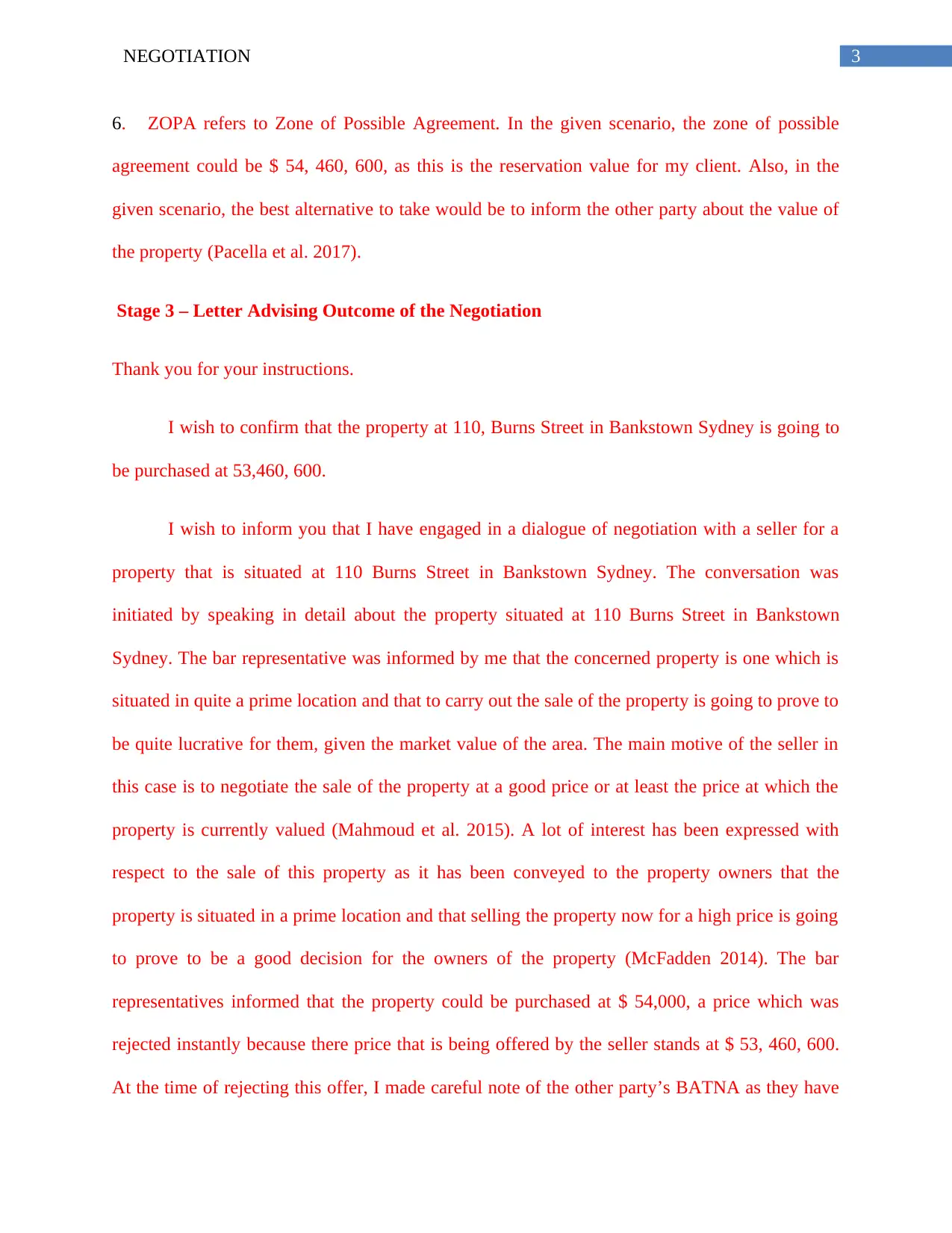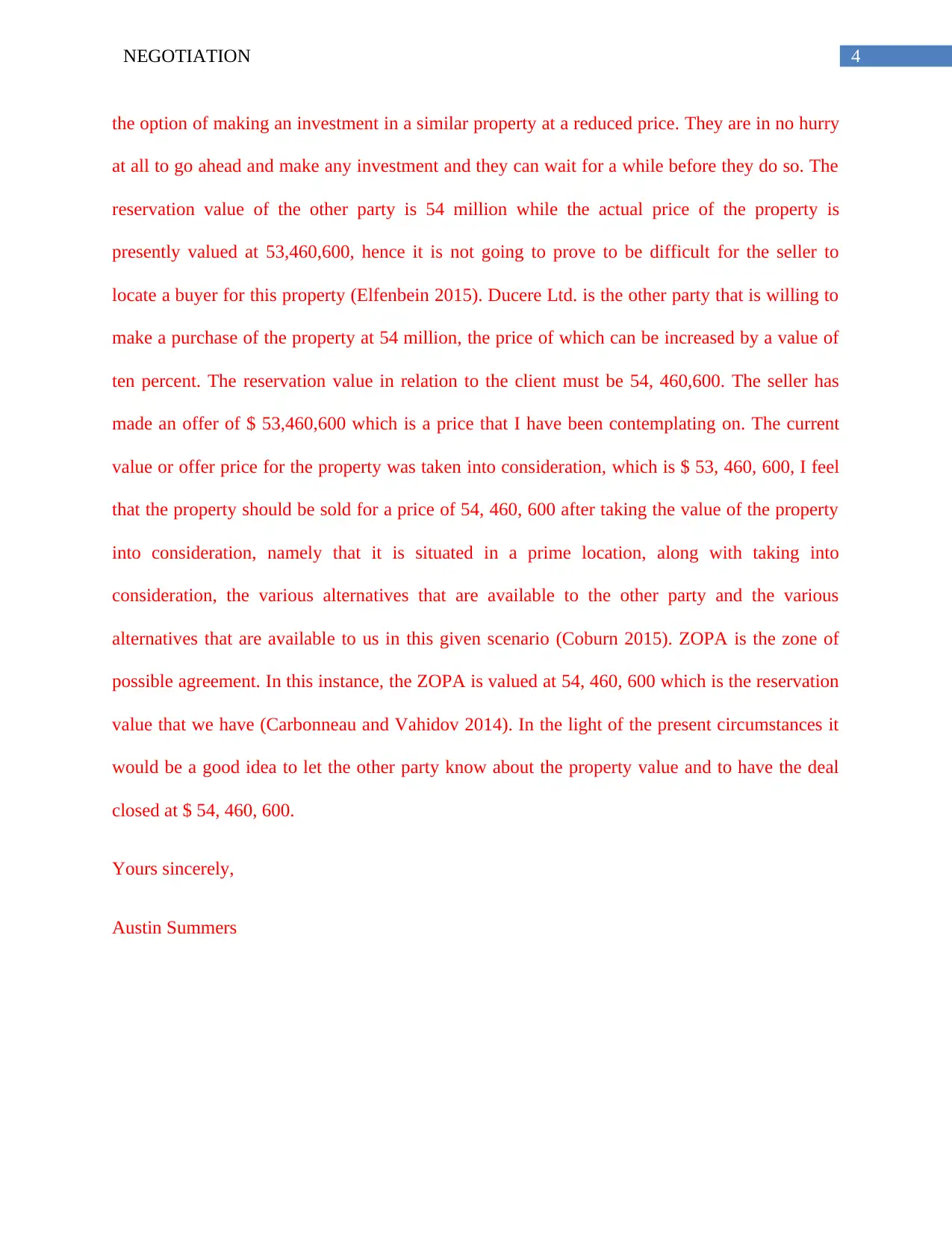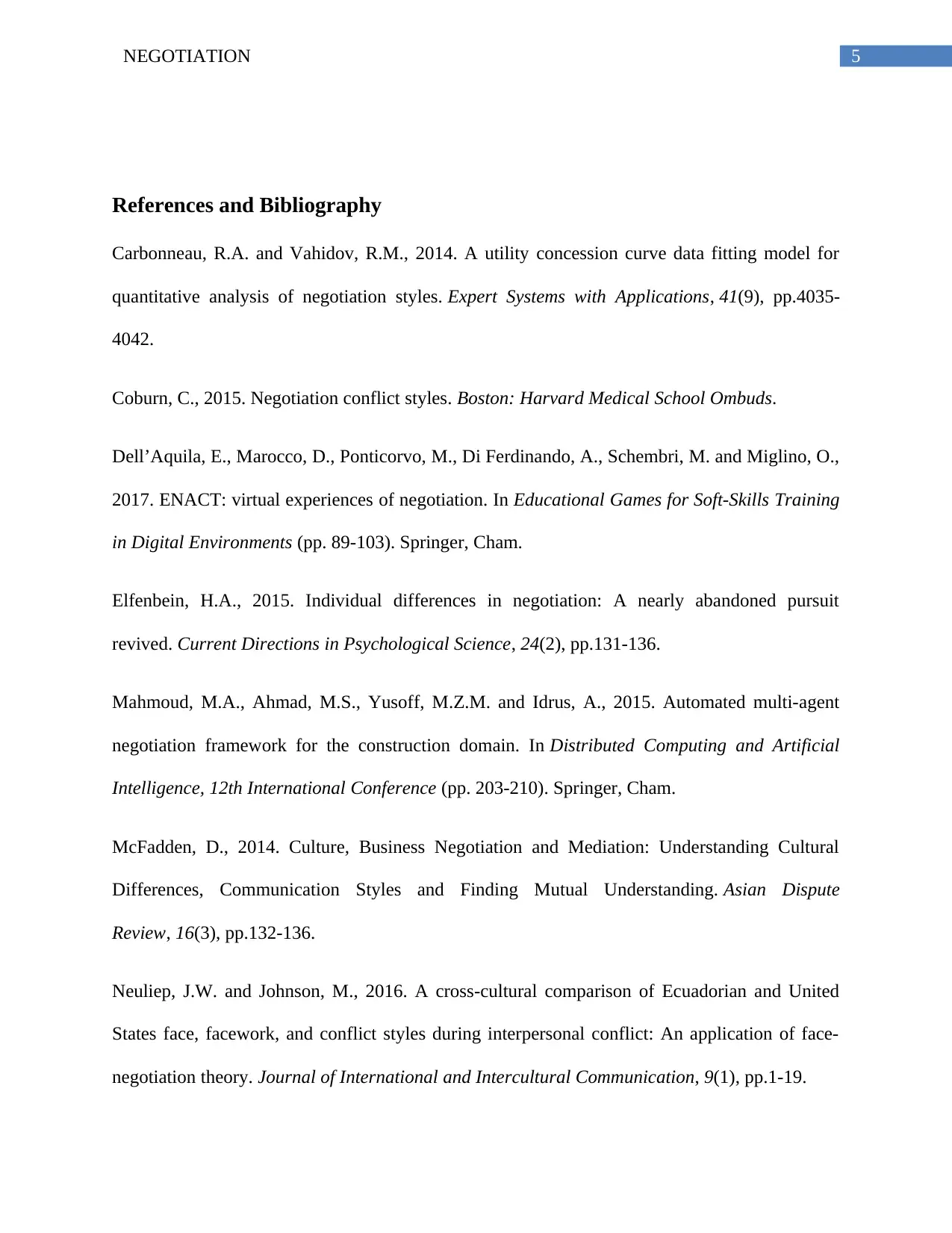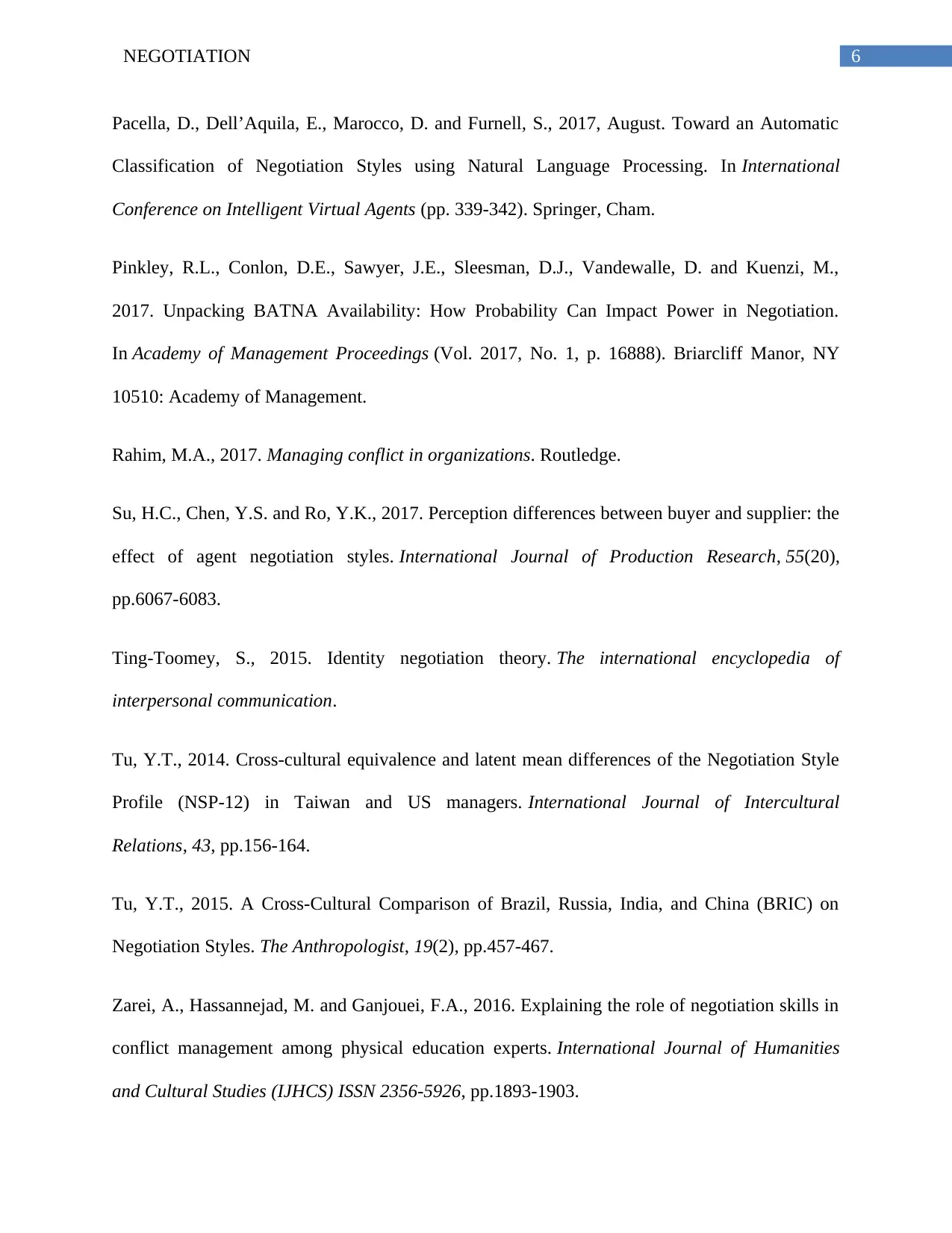Negotiation Report: Analysis of Asset Purchase and Negotiation
VerifiedAdded on 2022/09/17
|8
|1941
|23
Report
AI Summary
This report details a student's analysis of a negotiation scenario concerning the purchase of a commercial asset. The report begins by assessing the student's thinking style preferences and suggesting adjustments for optimal negotiation. It then identifies the client's and the other party's BATNA (Best Alternative To a Negotiated Agreement) and reservation values, crucial for understanding the Zone of Possible Agreement (ZOPA). The student outlines the negotiation process, including the initial offer, counteroffers, and the final agreement to purchase the property at $53,460,600. The report demonstrates an understanding of negotiation tactics, including the importance of knowing the other party's alternatives and reservation values to achieve a favorable outcome. The report concludes with a letter advising the outcome of the negotiation, confirming the purchase details and summarizing the key points discussed during the negotiation process, highlighting the strategic decisions made to reach an agreement.

Running head: NEGOTIATION
Negotiation
Name of the Student
Name of the University
Author Note
Negotiation
Name of the Student
Name of the University
Author Note
Paraphrase This Document
Need a fresh take? Get an instant paraphrase of this document with our AI Paraphraser

1NEGOTIATION
Stage 1 – Pre-Negotiation
2. Are your thinking style preferences – form and scope – optimal for conducting this
negotiation?
The given scenario is one where I have been appointed to engage in a negotiation
concerning the purchase of an asset. Various strategies are available using which sales
negotiations can be carried out (Zarei et al. 2016). Hence the process of negotiation does not
happen to be an organized one and there are random strategies that may be deployed with regards
to this particular situation (Ting – Tooney 2015). Additionally, while making sure that the asset
can be bought for a price which is considered as favorable for the client, what also has to be
ensured is that I work actively alongside others, in order to negotiate this sale on behalf of my
client (Tu 2014). With regard to the property purchase, I have to learn to work in a team
alongside others, and get along with others comfortably and easily so as to ensure good social
contact in the process. This external scope that is going to be adopted by me is going to serve me
well in negotiating the purchase in an appropriate manner (Dell-Acquila et al. 2017).
3. What adjustments (if any) could you make to adapt to a more optimal thinking style for
this negotiation?
A few adjustments have to be made with regard to the form of thinking that I am
deploying with respect to this particular negotiation (Tu 2015). At present, it is a hierarchical
form of thinking that I have deployed to the given scenario, which is a form of thinking that
provides me with a structure and organization along with a great deal of flexibility as well (Su et
al. 2017). However, when negotiating the purchase of a valuable asset, there is the need for
having a fixed plan or concept in mind, a style which is often referred to as monarchic thinking
Stage 1 – Pre-Negotiation
2. Are your thinking style preferences – form and scope – optimal for conducting this
negotiation?
The given scenario is one where I have been appointed to engage in a negotiation
concerning the purchase of an asset. Various strategies are available using which sales
negotiations can be carried out (Zarei et al. 2016). Hence the process of negotiation does not
happen to be an organized one and there are random strategies that may be deployed with regards
to this particular situation (Ting – Tooney 2015). Additionally, while making sure that the asset
can be bought for a price which is considered as favorable for the client, what also has to be
ensured is that I work actively alongside others, in order to negotiate this sale on behalf of my
client (Tu 2014). With regard to the property purchase, I have to learn to work in a team
alongside others, and get along with others comfortably and easily so as to ensure good social
contact in the process. This external scope that is going to be adopted by me is going to serve me
well in negotiating the purchase in an appropriate manner (Dell-Acquila et al. 2017).
3. What adjustments (if any) could you make to adapt to a more optimal thinking style for
this negotiation?
A few adjustments have to be made with regard to the form of thinking that I am
deploying with respect to this particular negotiation (Tu 2015). At present, it is a hierarchical
form of thinking that I have deployed to the given scenario, which is a form of thinking that
provides me with a structure and organization along with a great deal of flexibility as well (Su et
al. 2017). However, when negotiating the purchase of a valuable asset, there is the need for
having a fixed plan or concept in mind, a style which is often referred to as monarchic thinking

2NEGOTIATION
(Rahim 2017). I must combine both hierarchical and monarchic forms of thinking as this will
help me to carry out the negotiation well while giving me the flexibility that I need for this
purpose (Pinkley et al. 2017).
4. What is your client’s BATNA? What is your client’s reservation value?
In the given scenario, the Best Alternative To Negotiable Agreement or BATNA that is
available to my client is $ 54,460, 000
The value of the property stands at $ 53,460,600 hence to purchase this
propertyfor this is not going to prove to be difficult.
There is a potential buyer at Ducere Ltd. and who is willing to purchase property
at 54 million and which can be increased by a value of 10 percent.
The reservation value with regard to the client should be $ 54,460, 600.
5. What is the other party’s BATNA? What is the other party’s reservation value?
In the given scenario, the Best Alternative to Negotiable Agreement or BATNA that is
available to the other party is that –
They could make an investment in another asset of a similar type and which is also
available for a reduced price.
They could wait for a certain period of time before they go ahead and make an
investment as they appear to be in no hurry at all when it comes to indulging in asset
purchase.
The reservation value when it comes to the other party should be fixed at 54 million.
(Rahim 2017). I must combine both hierarchical and monarchic forms of thinking as this will
help me to carry out the negotiation well while giving me the flexibility that I need for this
purpose (Pinkley et al. 2017).
4. What is your client’s BATNA? What is your client’s reservation value?
In the given scenario, the Best Alternative To Negotiable Agreement or BATNA that is
available to my client is $ 54,460, 000
The value of the property stands at $ 53,460,600 hence to purchase this
propertyfor this is not going to prove to be difficult.
There is a potential buyer at Ducere Ltd. and who is willing to purchase property
at 54 million and which can be increased by a value of 10 percent.
The reservation value with regard to the client should be $ 54,460, 600.
5. What is the other party’s BATNA? What is the other party’s reservation value?
In the given scenario, the Best Alternative to Negotiable Agreement or BATNA that is
available to the other party is that –
They could make an investment in another asset of a similar type and which is also
available for a reduced price.
They could wait for a certain period of time before they go ahead and make an
investment as they appear to be in no hurry at all when it comes to indulging in asset
purchase.
The reservation value when it comes to the other party should be fixed at 54 million.
⊘ This is a preview!⊘
Do you want full access?
Subscribe today to unlock all pages.

Trusted by 1+ million students worldwide

3NEGOTIATION
6. ZOPA refers to Zone of Possible Agreement. In the given scenario, the zone of possible
agreement could be $ 54, 460, 600, as this is the reservation value for my client. Also, in the
given scenario, the best alternative to take would be to inform the other party about the value of
the property (Pacella et al. 2017).
Stage 3 – Letter Advising Outcome of the Negotiation
Thank you for your instructions.
I wish to confirm that the property at 110, Burns Street in Bankstown Sydney is going to
be purchased at 53,460, 600.
I wish to inform you that I have engaged in a dialogue of negotiation with a seller for a
property that is situated at 110 Burns Street in Bankstown Sydney. The conversation was
initiated by speaking in detail about the property situated at 110 Burns Street in Bankstown
Sydney. The bar representative was informed by me that the concerned property is one which is
situated in quite a prime location and that to carry out the sale of the property is going to prove to
be quite lucrative for them, given the market value of the area. The main motive of the seller in
this case is to negotiate the sale of the property at a good price or at least the price at which the
property is currently valued (Mahmoud et al. 2015). A lot of interest has been expressed with
respect to the sale of this property as it has been conveyed to the property owners that the
property is situated in a prime location and that selling the property now for a high price is going
to prove to be a good decision for the owners of the property (McFadden 2014). The bar
representatives informed that the property could be purchased at $ 54,000, a price which was
rejected instantly because there price that is being offered by the seller stands at $ 53, 460, 600.
At the time of rejecting this offer, I made careful note of the other party’s BATNA as they have
6. ZOPA refers to Zone of Possible Agreement. In the given scenario, the zone of possible
agreement could be $ 54, 460, 600, as this is the reservation value for my client. Also, in the
given scenario, the best alternative to take would be to inform the other party about the value of
the property (Pacella et al. 2017).
Stage 3 – Letter Advising Outcome of the Negotiation
Thank you for your instructions.
I wish to confirm that the property at 110, Burns Street in Bankstown Sydney is going to
be purchased at 53,460, 600.
I wish to inform you that I have engaged in a dialogue of negotiation with a seller for a
property that is situated at 110 Burns Street in Bankstown Sydney. The conversation was
initiated by speaking in detail about the property situated at 110 Burns Street in Bankstown
Sydney. The bar representative was informed by me that the concerned property is one which is
situated in quite a prime location and that to carry out the sale of the property is going to prove to
be quite lucrative for them, given the market value of the area. The main motive of the seller in
this case is to negotiate the sale of the property at a good price or at least the price at which the
property is currently valued (Mahmoud et al. 2015). A lot of interest has been expressed with
respect to the sale of this property as it has been conveyed to the property owners that the
property is situated in a prime location and that selling the property now for a high price is going
to prove to be a good decision for the owners of the property (McFadden 2014). The bar
representatives informed that the property could be purchased at $ 54,000, a price which was
rejected instantly because there price that is being offered by the seller stands at $ 53, 460, 600.
At the time of rejecting this offer, I made careful note of the other party’s BATNA as they have
Paraphrase This Document
Need a fresh take? Get an instant paraphrase of this document with our AI Paraphraser

4NEGOTIATION
the option of making an investment in a similar property at a reduced price. They are in no hurry
at all to go ahead and make any investment and they can wait for a while before they do so. The
reservation value of the other party is 54 million while the actual price of the property is
presently valued at 53,460,600, hence it is not going to prove to be difficult for the seller to
locate a buyer for this property (Elfenbein 2015). Ducere Ltd. is the other party that is willing to
make a purchase of the property at 54 million, the price of which can be increased by a value of
ten percent. The reservation value in relation to the client must be 54, 460,600. The seller has
made an offer of $ 53,460,600 which is a price that I have been contemplating on. The current
value or offer price for the property was taken into consideration, which is $ 53, 460, 600, I feel
that the property should be sold for a price of 54, 460, 600 after taking the value of the property
into consideration, namely that it is situated in a prime location, along with taking into
consideration, the various alternatives that are available to the other party and the various
alternatives that are available to us in this given scenario (Coburn 2015). ZOPA is the zone of
possible agreement. In this instance, the ZOPA is valued at 54, 460, 600 which is the reservation
value that we have (Carbonneau and Vahidov 2014). In the light of the present circumstances it
would be a good idea to let the other party know about the property value and to have the deal
closed at $ 54, 460, 600.
Yours sincerely,
Austin Summers
the option of making an investment in a similar property at a reduced price. They are in no hurry
at all to go ahead and make any investment and they can wait for a while before they do so. The
reservation value of the other party is 54 million while the actual price of the property is
presently valued at 53,460,600, hence it is not going to prove to be difficult for the seller to
locate a buyer for this property (Elfenbein 2015). Ducere Ltd. is the other party that is willing to
make a purchase of the property at 54 million, the price of which can be increased by a value of
ten percent. The reservation value in relation to the client must be 54, 460,600. The seller has
made an offer of $ 53,460,600 which is a price that I have been contemplating on. The current
value or offer price for the property was taken into consideration, which is $ 53, 460, 600, I feel
that the property should be sold for a price of 54, 460, 600 after taking the value of the property
into consideration, namely that it is situated in a prime location, along with taking into
consideration, the various alternatives that are available to the other party and the various
alternatives that are available to us in this given scenario (Coburn 2015). ZOPA is the zone of
possible agreement. In this instance, the ZOPA is valued at 54, 460, 600 which is the reservation
value that we have (Carbonneau and Vahidov 2014). In the light of the present circumstances it
would be a good idea to let the other party know about the property value and to have the deal
closed at $ 54, 460, 600.
Yours sincerely,
Austin Summers

5NEGOTIATION
References and Bibliography
Carbonneau, R.A. and Vahidov, R.M., 2014. A utility concession curve data fitting model for
quantitative analysis of negotiation styles. Expert Systems with Applications, 41(9), pp.4035-
4042.
Coburn, C., 2015. Negotiation conflict styles. Boston: Harvard Medical School Ombuds.
Dell’Aquila, E., Marocco, D., Ponticorvo, M., Di Ferdinando, A., Schembri, M. and Miglino, O.,
2017. ENACT: virtual experiences of negotiation. In Educational Games for Soft-Skills Training
in Digital Environments (pp. 89-103). Springer, Cham.
Elfenbein, H.A., 2015. Individual differences in negotiation: A nearly abandoned pursuit
revived. Current Directions in Psychological Science, 24(2), pp.131-136.
Mahmoud, M.A., Ahmad, M.S., Yusoff, M.Z.M. and Idrus, A., 2015. Automated multi-agent
negotiation framework for the construction domain. In Distributed Computing and Artificial
Intelligence, 12th International Conference (pp. 203-210). Springer, Cham.
McFadden, D., 2014. Culture, Business Negotiation and Mediation: Understanding Cultural
Differences, Communication Styles and Finding Mutual Understanding. Asian Dispute
Review, 16(3), pp.132-136.
Neuliep, J.W. and Johnson, M., 2016. A cross-cultural comparison of Ecuadorian and United
States face, facework, and conflict styles during interpersonal conflict: An application of face-
negotiation theory. Journal of International and Intercultural Communication, 9(1), pp.1-19.
References and Bibliography
Carbonneau, R.A. and Vahidov, R.M., 2014. A utility concession curve data fitting model for
quantitative analysis of negotiation styles. Expert Systems with Applications, 41(9), pp.4035-
4042.
Coburn, C., 2015. Negotiation conflict styles. Boston: Harvard Medical School Ombuds.
Dell’Aquila, E., Marocco, D., Ponticorvo, M., Di Ferdinando, A., Schembri, M. and Miglino, O.,
2017. ENACT: virtual experiences of negotiation. In Educational Games for Soft-Skills Training
in Digital Environments (pp. 89-103). Springer, Cham.
Elfenbein, H.A., 2015. Individual differences in negotiation: A nearly abandoned pursuit
revived. Current Directions in Psychological Science, 24(2), pp.131-136.
Mahmoud, M.A., Ahmad, M.S., Yusoff, M.Z.M. and Idrus, A., 2015. Automated multi-agent
negotiation framework for the construction domain. In Distributed Computing and Artificial
Intelligence, 12th International Conference (pp. 203-210). Springer, Cham.
McFadden, D., 2014. Culture, Business Negotiation and Mediation: Understanding Cultural
Differences, Communication Styles and Finding Mutual Understanding. Asian Dispute
Review, 16(3), pp.132-136.
Neuliep, J.W. and Johnson, M., 2016. A cross-cultural comparison of Ecuadorian and United
States face, facework, and conflict styles during interpersonal conflict: An application of face-
negotiation theory. Journal of International and Intercultural Communication, 9(1), pp.1-19.
⊘ This is a preview!⊘
Do you want full access?
Subscribe today to unlock all pages.

Trusted by 1+ million students worldwide

6NEGOTIATION
Pacella, D., Dell’Aquila, E., Marocco, D. and Furnell, S., 2017, August. Toward an Automatic
Classification of Negotiation Styles using Natural Language Processing. In International
Conference on Intelligent Virtual Agents (pp. 339-342). Springer, Cham.
Pinkley, R.L., Conlon, D.E., Sawyer, J.E., Sleesman, D.J., Vandewalle, D. and Kuenzi, M.,
2017. Unpacking BATNA Availability: How Probability Can Impact Power in Negotiation.
In Academy of Management Proceedings (Vol. 2017, No. 1, p. 16888). Briarcliff Manor, NY
10510: Academy of Management.
Rahim, M.A., 2017. Managing conflict in organizations. Routledge.
Su, H.C., Chen, Y.S. and Ro, Y.K., 2017. Perception differences between buyer and supplier: the
effect of agent negotiation styles. International Journal of Production Research, 55(20),
pp.6067-6083.
Ting‐Toomey, S., 2015. Identity negotiation theory. The international encyclopedia of
interpersonal communication.
Tu, Y.T., 2014. Cross-cultural equivalence and latent mean differences of the Negotiation Style
Profile (NSP-12) in Taiwan and US managers. International Journal of Intercultural
Relations, 43, pp.156-164.
Tu, Y.T., 2015. A Cross-Cultural Comparison of Brazil, Russia, India, and China (BRIC) on
Negotiation Styles. The Anthropologist, 19(2), pp.457-467.
Zarei, A., Hassannejad, M. and Ganjouei, F.A., 2016. Explaining the role of negotiation skills in
conflict management among physical education experts. International Journal of Humanities
and Cultural Studies (IJHCS) ISSN 2356-5926, pp.1893-1903.
Pacella, D., Dell’Aquila, E., Marocco, D. and Furnell, S., 2017, August. Toward an Automatic
Classification of Negotiation Styles using Natural Language Processing. In International
Conference on Intelligent Virtual Agents (pp. 339-342). Springer, Cham.
Pinkley, R.L., Conlon, D.E., Sawyer, J.E., Sleesman, D.J., Vandewalle, D. and Kuenzi, M.,
2017. Unpacking BATNA Availability: How Probability Can Impact Power in Negotiation.
In Academy of Management Proceedings (Vol. 2017, No. 1, p. 16888). Briarcliff Manor, NY
10510: Academy of Management.
Rahim, M.A., 2017. Managing conflict in organizations. Routledge.
Su, H.C., Chen, Y.S. and Ro, Y.K., 2017. Perception differences between buyer and supplier: the
effect of agent negotiation styles. International Journal of Production Research, 55(20),
pp.6067-6083.
Ting‐Toomey, S., 2015. Identity negotiation theory. The international encyclopedia of
interpersonal communication.
Tu, Y.T., 2014. Cross-cultural equivalence and latent mean differences of the Negotiation Style
Profile (NSP-12) in Taiwan and US managers. International Journal of Intercultural
Relations, 43, pp.156-164.
Tu, Y.T., 2015. A Cross-Cultural Comparison of Brazil, Russia, India, and China (BRIC) on
Negotiation Styles. The Anthropologist, 19(2), pp.457-467.
Zarei, A., Hassannejad, M. and Ganjouei, F.A., 2016. Explaining the role of negotiation skills in
conflict management among physical education experts. International Journal of Humanities
and Cultural Studies (IJHCS) ISSN 2356-5926, pp.1893-1903.
Paraphrase This Document
Need a fresh take? Get an instant paraphrase of this document with our AI Paraphraser

7NEGOTIATION
1 out of 8
Related Documents
Your All-in-One AI-Powered Toolkit for Academic Success.
+13062052269
info@desklib.com
Available 24*7 on WhatsApp / Email
![[object Object]](/_next/static/media/star-bottom.7253800d.svg)
Unlock your academic potential
Copyright © 2020–2025 A2Z Services. All Rights Reserved. Developed and managed by ZUCOL.





